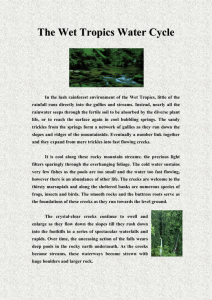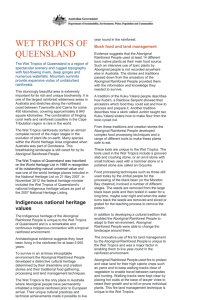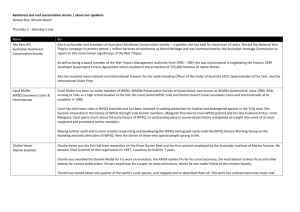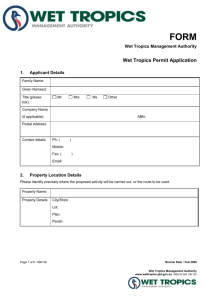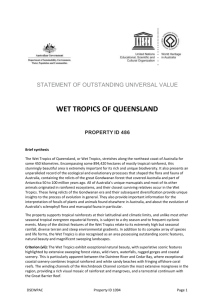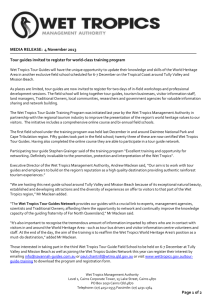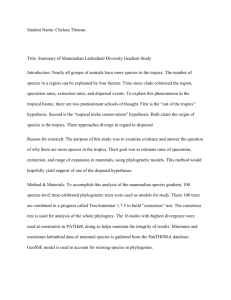AUSTRALIA`S WORLD HERITAGE PLACES
advertisement
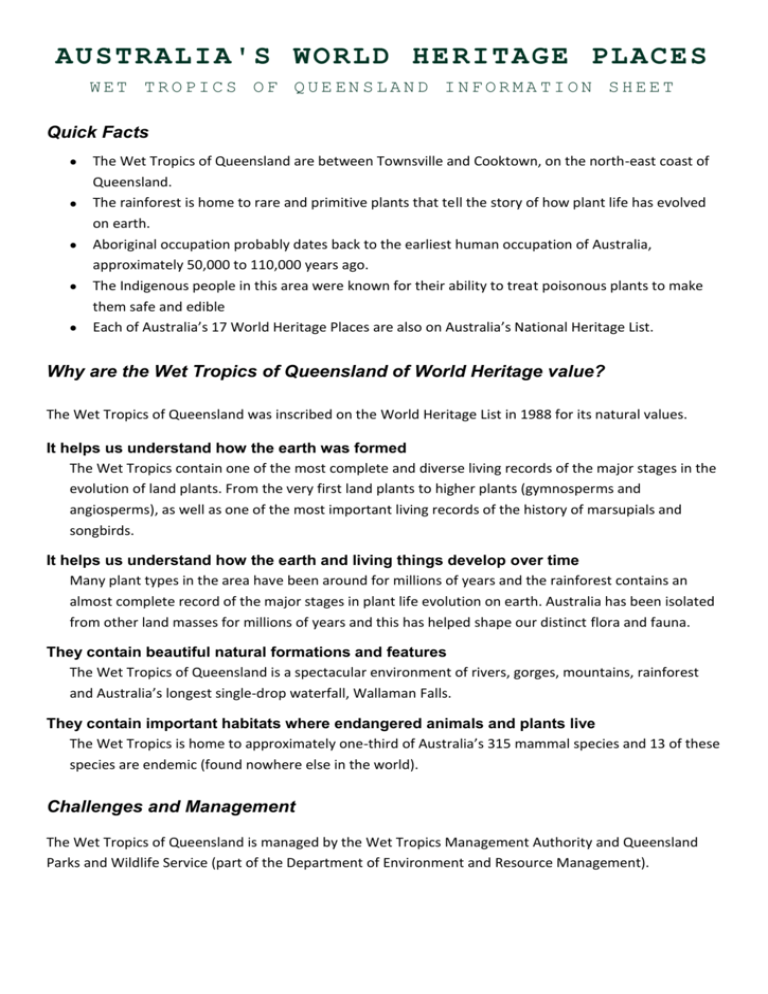
AUST RA L IA'S W O RLD HE R ITAG E P LACE S WET TROPICS OF QUEENSLAND INFORMATION SHEET Quick Facts The Wet Tropics of Queensland are between Townsville and Cooktown, on the north-east coast of Queensland. The rainforest is home to rare and primitive plants that tell the story of how plant life has evolved on earth. Aboriginal occupation probably dates back to the earliest human occupation of Australia, approximately 50,000 to 110,000 years ago. The Indigenous people in this area were known for their ability to treat poisonous plants to make them safe and edible Each of Australia’s 17 World Heritage Places are also on Australia’s National Heritage List. Why are the Wet Tropics of Queensland of World Heritage value? The Wet Tropics of Queensland was inscribed on the World Heritage List in 1988 for its natural values. It helps us understand how the earth was formed The Wet Tropics contain one of the most complete and diverse living records of the major stages in the evolution of land plants. From the very first land plants to higher plants (gymnosperms and angiosperms), as well as one of the most important living records of the history of marsupials and songbirds. It helps us understand how the earth and living things develop over time Many plant types in the area have been around for millions of years and the rainforest contains an almost complete record of the major stages in plant life evolution on earth. Australia has been isolated from other land masses for millions of years and this has helped shape our distinct flora and fauna. They contain beautiful natural formations and features The Wet Tropics of Queensland is a spectacular environment of rivers, gorges, mountains, rainforest and Australia’s longest single-drop waterfall, Wallaman Falls. They contain important habitats where endangered animals and plants live The Wet Tropics is home to approximately one-third of Australia’s 315 mammal species and 13 of these species are endemic (found nowhere else in the world). Challenges and Management The Wet Tropics of Queensland is managed by the Wet Tropics Management Authority and Queensland Parks and Wildlife Service (part of the Department of Environment and Resource Management). Challenges Management Fragmentation Some areas of the Wet Tropics have roads, tracks, powerlines, dams and vegetation clearings which stop wildlife moving freely. To help decrease road kill, rope overpasses and highway underpasses have been built to allow animals to safely cross under or over roads. In addition, road signs, speed humps and road markings are in place for traffic to slow down at popular wildlife crossings Climate change Scientists predict that global warming could affect the habitat in the cooler rainforest areas. It is predicted that a 1ºC temperature increase could cause seven frog species, five mammal species, three bird species and three skink species to lose more than half their current habitat. The following activities are in place to help fight climate change: Improving overall rainforest health, making it more resilient Increasing community awareness Increasing knowledge through research Improving planning and coordination between all parties involved in managing the World Heritage Place Introduced species Introduced weeds are a major concern as they crowd out native plant species and block waterways. For example, Salvinia which has escaped from garden ponds, covers waterways with thick leaves and blocks sunlight, causing underwater plants to die. When a plant is identified as a threat, action can be taken to eliminate it or reduce its numbers. Cats, dogs, wild pigs, cane toads and deer are some of the feral animals threatening native plants and animals. Some methods used to control them are poison baits, traps and fences. Fire management Certain areas of the Wet Tropics respond differently to fire. For example, eucalyptus forests and woodlands need regular fires to survive. Several management authorities work together with Indigenous communities to manage fires whilst research and monitoring help provide a better understanding of fire and the different ecosystems. Read more www.environment.gov.au/heritage/places/world/wet-tropics/index.html
